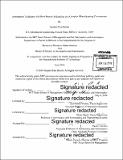Automation techniques for short interval scheduling in a complex manufacturing environment
Author(s)
Baxter, Stephen Paul
DownloadFull printable version (5.185Mb)
Other Contributors
Leaders for Global Operations Program.
Advisor
Oli de Weck and Juan Pablo Vielma.
Terms of use
Metadata
Show full item recordAbstract
Aircraft Company X (ACX) designs and manufactures aircraft. ACX operates Manufacturing Center 1 which produces parts and assemblies for both assembly and spares business lines. Accurate scheduling is crucial for meeting demand and the on time delivery of parts, a key driver of customer satisfaction. Managers currently use a manual process to generate a short interval schedule for production in this volatile, high variety, low volume environment with reentrant flow. The current process is not only time consuming but also disrupts coordination between supporting functions. This thesis explores the challenges of developing and implementing an automated scheduling tool in a flexible job shop with re-entrant flow, part families, sequence dependent set-up times, and machine eligibility restrictions. First, a model is developed from current scheduling rules used by shop floor supervisors. The model uses the earliest due date dispatching rule and part family information to schedule a group of parallel machines. This model is then incorporated into a scheduling tool, which is implemented and tested in the plant. Finally, the results of the implementation are discussed along with improvement to the tool. The purposed tool demonstrated during testing the ability to save a significant amount of the supervisors' time by reducing their involvement in scheduling, to reduce set-up times by grouping similar parts, and to align support functions by providing a unified build plan for the plant.
Description
Thesis: M.B.A., Massachusetts Institute of Technology, Sloan School of Management, 2016. In conjunction with the Leaders for Global Operations Program at MIT. Thesis: S.M. in Engineering Systems, Massachusetts Institute of Technology, Department of Aeronautics and Astronautics, 2016. In conjunction with the Leaders for Global Operations Program at MIT. Cataloged from PDF version of thesis. Includes bibliographical references (page 43).
Date issued
2016Department
Leaders for Global Operations Program at MIT; Massachusetts Institute of Technology. Department of Aeronautics and Astronautics; Sloan School of ManagementPublisher
Massachusetts Institute of Technology
Keywords
Sloan School of Management., Aeronautics and Astronautics., Leaders for Global Operations Program.